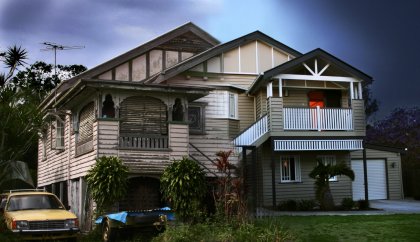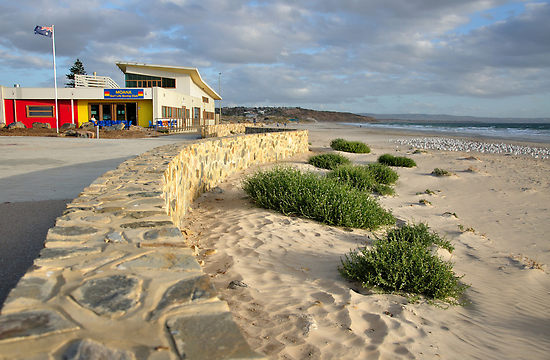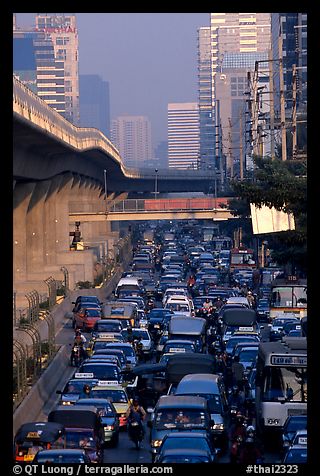[This article was initially posted as a comment in response to Brian McGavin's article 'Report on conference to find 10 best of 20 climate solutions'].
 A 'Queenslander' style family home in Brisbane
A 'Queenslander' style family home in Brisbane
If "Australia was a big country well able to absorb a bigger population" [Ed Miliband, UK Climate and Energy Secretary], then we would have full employment, public infrastructure and services would have excess capacity ready to cope, federal and state governments would be in surplus and there would be no undue pressures on our economy, society or ecology. But this is clearly not the case - just read any newspaper in Australia. It's obvious when commuting to work. Try getting a job. Try getting elective surgery. Try booking children into a school or toddlers into childcare. Try buying a house.
.jpg) Edward Miliband, an economist and now somehow qualified to be UK Secretary of State for Energy and Climate Change in Britain's Labor Party, and somehow qualified to be an authority on Australia and its population capacity and ecological footprint - or else really an ambitious UK polly who will say anything before checking his facts, and who has no expertise on Australia or in population sociology?
Edward Miliband, an economist and now somehow qualified to be UK Secretary of State for Energy and Climate Change in Britain's Labor Party, and somehow qualified to be an authority on Australia and its population capacity and ecological footprint - or else really an ambitious UK polly who will say anything before checking his facts, and who has no expertise on Australia or in population sociology?
Demand stress upon all resources is worsening and at its root, this demand is driven by the growth of human population and its proportionate demand for scarce resources.
What is needed to clarify the problem is to establish measures and benchmarks. The ‘best or most favourable’ population for Australia and each of its cities and regions will be its 'optimum population'. This is one key benchmark. It is a more appropriate measure than 'sustainable population', because 'sustainable' implies the maximum possible, which is a less than ideal outcome. If Australians want to live in congestion akin to Bangkok or Hong Kong, then even if our resources could be pushed further to the sustainable limit, Australia's 'sustainable population' would be a scary number!
But how do we measure the benchmark of 'optimum population'? The Optimum Population Trust (OPT) approaches this measurement by applying the test of ecological footprinting (or eco-footprinting) This seeks to measure the ecological carrying capacity of a district, province, country, global region and even the whole planet. Carrying capacity is defined by OPT as "the size of human population that can be supported in a given territory, in a specified life-style (for example 'Modest European'), without degrading its physical and ecological environment, and without imposing wastes on the global environment beyond a specified limit." OPT Research Co-ordinator Andrew Ferguson defines eco-footprinting as "the process of determining the bioproductive area that a person or a population needs in order to sustain a specified lifestyle."
So the test then comes down to one of lifestyle. Lifestyle is a familiar term but one worth defining at this point. Dictionary .com defines lifestyle as "the habits, attitudes, tastes, moral standards, economic level, etc., that together constitute the mode of living of an individual or group." Perhaps Australians should reflect on this definition -'room to move', 'low cost of living', health, individual freedoms, access to opportunities, access to resources, etc. In Australia, we apparently have one of the best lifestyles on the planet. Australian lifestyle is made up of a set of values that should not be taken for granted.
So if eco-footprinting is about the relationship between a bioproductive area of a person or population to sustain a specified lifestyle, then this assumes lifestyle is inversely proportional to population - where the larger the population and faster the growth of that population the lower the standard of lifestyle - 'room to move', lower costs, opportunities, resource access, reduced competition, etc. In Australia, we apparently have one of the best lifestyles on the planet.
But this is relative and these days it depends on where one lives in Australia and one's socio-economic status. Back in the 1960's Australia was arguably a classless society. These days not so. In 1960 Australia's population was 10 million. In 1970 it was 12 million. In 1980 it was 14 million. In 1990 it was 17 million. In 2009 it is 21.8 million and increasing exponentially currently at 300,000 per year and could reach $23 million by 2010. So in 50 years, Australia's population has more than doubled. With current government policy at both federal and state levels our population will likely double again to 50 million in less than 50 years. Based on policies and historical trends to concentrate population in Australia's capital cities, this means Sydney, Melbourne and Brisbane and other major cities will be twice the size they are now. Imagine that for a moment! This is the real risk. It is frankly the biggest problem facing Australia.
Some other useful measures to better define the population growth problem are:
'Ecological footprint' is defined by the World Wildlife Fund as "an ecological footprint compares countries' consumption of natural resources with the Earth's biological capacity to regenerate them," or "a measure of humanity's use of renewable resources."
'Ecological space' is "the biologically productive space available to each person on the planet. Divided into equal shares (i.e. divided by world population) it was 5 - 6 hectares per person in 1900 and decreased to 1.5 hectares per person by 2000. Ecological space can expand or shrink depending on resource consumption, technological innovation, population growth and other factors."
Hectare, global (gha) "In eco-footprinting, 1 hectare (10,000m2, or 100m x 100m) of biologically productive space with world-average productivity. In 2002 the biosphere had 11.4 billion hectares of biologically productive space corresponding to roughly one quarter of the planet's surface. These 11.4 billion hectares include 2 billion hectares of cropland, 3.5 billion hectares of grazing land, 3.8 billion hectares of forest land, 0.3 billion hectares of inland waters and 0.3 hectares of built-up land. One global hectare is therefore a hectare representing the average capacity of one of these 11.4 billion hectares. Thus a hectare of highly productive land represents more 'global hectares' than the same surface of less productive land. Global hectares allow the meaningful comparison of the ecological footprints of different countries, which use different qualities and mixes of cropland, grazing land, and forest."
Becoming familiar with these measures and benchmarks will enable us to have a clearer understanding about what population numbers and growth Australia and Auatralians can indeed 'absorb'.
 Moama Beach, South Australia...with many hectares per person (and seagull).
Moama Beach, South Australia...with many hectares per person (and seagull).


Add comment